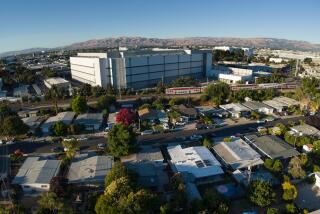In the Oncoming Lane of the Info Highway : Television: Cable operator CVI is planning a fiber-optic upgrade to deliver expanded services, including, potentially, telecommunications.
- Share via
The San Fernando Valley’s largest cable television operator will invest $20 million during the next four years in new fiber-optic technology that will give it the ability to greatly expand its services.
Under the direction of newly installed vice president and general manager Tom Schaeffer, Chatsworth-based CVI, West Valley, plans to start replacing its infrastructure of coaxial cable with the more powerful technology at the first of the year.
The upgrade will initially allow CVI to expand the number of channels it offers its 95,000 subscribers from 60 to 77. But CVI’s management is preparing for the time when it may dispense services on the so-called information highway, such as video on demand, home shopping, security services, home banking and--if legislative hurdles eventually fall, as expected--telephone service.
If all this talk of delivering new information and interactive services has a familiar ring, it should. CVI’s fiber-optic upgrade comes after Pacific Bell announced plans last November to invest $16 billion over seven years to resurface its network in California. One of Pacific Bell’s first goals, if it gets the go-ahead from the federal government, is to deliver cable TV services. And one of the first areas it will target is the west San Fernando Valley--smack-dab in CVI’s territory.
Schaeffer insists that CVI’s upgrade was in the works long before Pac Bell made its plans public. CVI’s 17-year-old system has run out of space to add channels, and customers are clamoring for new programming services, he said. This is happening as an array of new competitors--including the phone company and satellite services such as DirecTV--are eagerly eyeing cable’s turf, threatening the monopolies most cable operators enjoy in their franchise areas.
So CVI is fighting back. The fiber-optic technology will give the cable system far greater capacity and the ability to run cable, data and voice signals over super-fast wires. In addition, Schaeffer is giving the system’s marketing and customer-service practices the once-over. “We’ve got to become competitive against the phone company or any other outside company,” he said.
To be sure, all this preparation for cable’s entry into the phone business is based on a future that might not come to pass. Most states, including California, prohibit cable companies from competing directly with local phone companies. But change is bearing down. The federal government is considering legislation that would preempt state regulations and allow cable companies to enter the telephone business and vice versa.
Pac Bell, too, is making plans to deliver video before it has the authority to do so. The Federal Communications Commission has yet to approve its request to provide these services throughout its phone service franchise. But the FCC has made it clear that it supports the principle of phone companies entering the video-delivery business. Pac Bell expects to receive approval soon.
National Cable Television Assn. spokesman Rich D’Amato said CVI’s technology program is part of a national trend. “Cable operators around the country are upgrading their systems with fiber optics in anticipation of providing increased services” and eventually competing with phone companies.
*
CVI’s neighbor, Ventura County Cablevision, for example, is in the third year of a six-year program installing fiber optics in the communities it serves. The upgrade has allowed that system to increase channel capacity. Eventually it will enable VCC to deliver advanced telecommunications services, said Christopher Lammers, president of Ventura County Cablevision’s parent, Western Communications in San Francisco.
Before CVI starts installing its new network, it must get city approval. Within two weeks, Schaeffer will submit a description of CVI’s rebuild plan to the Los Angeles Department of Telecommunications for review, and possible scrutiny by the City Council. If the city has no objections, it will take about 60 to 90 days to receive the green light.
CVI will tackle the upgrades in 15 phases. Plans call for Chatsworth to be the first community to get rewired by April 1, followed by Reseda, Northridge, Canoga Park and Encino. That means Chatsworth subscribers in designated areas will be able to receive 17 additional cable channels beginning April 1.
CVI is also considering investing several million dollars in digital compression. This is a computer-based technology that allows a cable operator to cram more capacity into its pipeline, and it would enable CVI to provide hundreds of channels. Schaeffer said officials at CVI’s parent company, privately held Cablevision Industries of Liberty, N.Y., are weighing whether the investment makes financial sense.
Cablevision Industries is the eighth-largest multi-system cable operator in the United States, with 1.32 million subscribers. CVI, West Valley, is the largest system it operates.
It’s not clear how quickly CVI will recoup its investment in fiber-optic technology.
Some of the pay-back will come from increased efficiency because fiber is cheaper to maintain than coaxial cable. Schaeffer said some cable rates may rise, but the new services will be offered to consumers in optional packages. Under the 1992 Cable Act, the FCC reduced basic cable rates by 17% on average, and set guidelines for how much operators can charge for basic services. The FCC and the cable industry are currently discussing how operators can recover costs such as those involved in fiber-optic upgrades, said the NCTA’s D’Amato.
Schaeffer has been at CVI for five months, arriving about two months after the Northridge earthquake knocked the system out for two days and cost it 6,000 customers as apartments and houses were destroyed. Schaeffer succeeded Tom Belcher, who left CVI last October to become vice president and general manager of PageNet in Los Angeles, the regional headquarters of the Plano, Tex.-based paging company.
Schaeffer, a 22-year cable industry veteran, recently spent two years in Britain as managing director of cable systems owned by a French conglomerate.
Schaeffer would not disclose the West Valley system’s financial results. Its primary revenue stream is the monthly fees customers pay for programming, supplemented by advertising sales and pay-per-view revenues. It also rents an on-site production facility to makers of TV commercials and series, such as “Behind Bars,” a syndicated documentary show.
In addition to the new services, Schaeffer hopes to pump up subscribership by using market research to find out what customers want. CVI will also step up direct-mail solicitation and telemarketing.
Leo Brennan, vice president of Dimension Cable in San Juan Capistrano (a Times Mirror cable system) and president of the Southern California Cable TV Assn., said the Southern California region is a tough market for cable operators to attract new customers. Not only is there a large number of broadcast channels, but the temperate climate means outdoor activities compete for consumers’ time and dollars, he said.
“We’ve got to become more creative in our ability to service the customer than ever before,” Schaeffer said. “It’s a cliche to say that today, but we’re not going to be in business if we don’t.”
More to Read
Inside the business of entertainment
The Wide Shot brings you news, analysis and insights on everything from streaming wars to production — and what it all means for the future.
You may occasionally receive promotional content from the Los Angeles Times.










